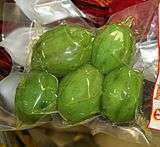Spondias
| Spondias | |
|---|---|
 | |
| Fruiting Spondias mombin | |
| Scientific classification | |
| Kingdom: | Plantae |
| (unranked): | Angiosperms |
| (unranked): | Eudicots |
| (unranked): | Rosids |
| Order: | Sapindales |
| Family: | Anacardiaceae |
| Subfamily: | Spondioideae |
| Tribe: | Spondiadeae |
| Genus: | Spondias L. |
| Type species | |
| Spondias mombin L. | |
| Species | |
|
17, see text | |
| Synonyms | |
|
Allospondias (Pierre) Stapf | |
Spondias is a genus of flowering plants in the cashew family, Anacardiaceae. The genus consists of 17 described species, 7 of which are native to the Neotropics and about 10 are native to tropical Asia. They are commonly named hog plums, Spanish plums, libas in Bikol and in some cases golden apples for their brightly colored fruit which resemble an apple or small plum at a casual glance. They are only distantly related to apple and plum trees, however. A more unequivocal common name is mombins.
A theory regarding the name of the city of Bangkok, Thailand is that the name is derived from makok (มะกอก), the Thai name for the fruit of Spondias dulcis.[2] In Cambodia, Spondias pinnata is called /pɷːn siː pʰlaɛ/ (ពោនស៊ីផ្លែ) or /məkaʔ prẹj/ (ម្កាក់ព្រៃ),[3] and Spondias dulcis simply /məkaʔ/ (ម្កាក់). Spondias pinnata is called Pulicha kaai in the Tamil language, which means "sour fruit." It is also called as "Amate Kaai" in Kannada language,Ambade in Tulu and Konkani. In Sri Lanka it is called Amberella.
Description
They are deciduous or semi-evergreen trees growing to 25 m tall. The leaves are spirally arranged, pinnate, rarely bipinnate or simple. The fruit is a drupe similar to a small mango (in the related genus Mangifera), 4–10 cm long, ripening yellow or orange. It has a single seed.
The Malesian species of Spondias were revised by Ding Hou in 1978.[4] The most recently recognized species, Spondias testudinis, was described in 1998.[5]
As food

About 10 species of Spondias bear edible fruits and have been domesticated for fruit production. These fruits are also consumed by herbivorous mammals such as deer.
In the Western Ghats of Karnataka flower buds and tender fruits are used in pickle preparation. In Thai cuisine both the fruits and the tender leaves are eaten.
Selected species
- Spondias cytherea Sonn.
- Spondias dulcis – Tahitian apple, pommecythere (Trinidad & Tobago)
- Spondias haplophylla
- Spondias indica
- Spondias lakonensis
- Spondias mombin – Yellow mombin, gully plum, Ashanti plum, "Java plum"
- Spondias pinnata
- Spondias purpurea L. – Jocote, purple mombin, red mombin, ciruela, siniguela, sirigwela
- Spondias radlkoferi
- Spondias tuberosa – Umbú, imbu, Brazil plum
- Spondias venulosa
References
- ↑ "Spondias L.". Germplasm Resources Information Network. United States Department of Agriculture. 2009-11-23. Retrieved 2010-02-12.
- ↑ "ชั้นและตำบลที่ตั้งวัด", watarun.org, accessed March 29, 2011.
- ↑ LETI, Mathieu, HUL Sovanmoly, Jean-Gabriel FOUCHÉ, CHENG Sun Kaing, Bruno DAVID, Flore photographique du Cambodge, Paris: Privat, 2013, p. 63.
- ↑ Flora Malesiana series 1, 8(3):395-577.
- ↑ John D. Mitchell and Douglas C. Daly. 1998. "The "tortoise's cajá" - a new species of Spondias (Anacardiaceae) from southwestern Amazonia" Brittonia 50( ):447-451.
External links
| Wikimedia Commons has media related to Spondias. |
![]() Data related to Spondias at Wikispecies
Data related to Spondias at Wikispecies